Services on Demand
Journal
Article
Indicators
-
 Cited by SciELO
Cited by SciELO -
 Access statistics
Access statistics
Related links
-
 Similars in
SciELO
Similars in
SciELO  uBio
uBio
Share
Revista Boliviana de Química
On-line version ISSN 0250-5460
Rev. Bol. Quim vol.29 no.1 La Paz 2012
ARTÍCULO ORIGINAL
PROTEIN ENRICHMENT OF ORIENTAL NOODLES BASED ON CANNA EDULIS STARCH
Stalin Santacruz 1Mari Pennanen 1-2, Jenny Ruales 1
'Department of Food Science and Biotechnology. Escuela Politécnica Nacional, Quito, Ecuador, Colegio de Agricultura, Alimentos y Nutrición, Universidad San Francisco de Quito, P.O. Box 17-12-841, Quito, Ecuador P.O. Box 17-12-841, Quito, Ecuador. 2University of Helsinki, Helsinki, Finland
Keywords: noodles, pre-gelatinization, starch, cooking stability, protein enrichment, Canna edulis
ABSTRACT
Spray drying, drum drying and extrusion cooking were applied in order to find out the best treatment for pre-gelatinization of Canna edulis starch for noodle processing. Spray-drying process manifested to be a gentle process to modify the native starch, whereas cooking extrusion was too drastic. Adding either native or pre-gelatinized C. edulis starch to wheat flour noodles increased the solid loss. Whereas noodles made of C. edulis only, showed lower cooked weight and solid loss than commercial samples. C. edulis noodles with the best cooking stability were obtained by mixing 12 % pre-gelatinized starch, 28% native starch and 60% water, submerging in boiling water for 60 seconds, cooling in water at room temperature (17°C) for 60 seconds and drying in oven at 17°C. A protein enrichment of C. edulis noodles by adding either lupine concentrate or defatted soybean flour showed that lupine-C. edulis and soybean-C. edulis mixtures had higher solid loss than noodles prepared by using C. edulis starch only. Sensory evaluation results showed that the cooling of noodles in water at room temperature did not make differences on the appearance and texture compared to samples cooled down at 0DC. C. edulis noodles of 1.5 mm and 0.8 mm diameter showed big differences with commercial samples. Moreover an improvement on the appearance and texture of C. edulis noodles was observed by reducing the noodles diameter from 1.5 to 0.8 mm. Acceptability tests of the protein enriched noodles showed that consumers had preference for the mixture Lupine-C. edulis.
INTRODUCTION
Canna edulis is an ancient Andean root crop, but it is little used today in its native area. Fibrous rhizome has a poor eating quality and a long cooking time, from two to five hours (1). However the relative high starch content of C. edulis (12 to 16 %) makes its extraction the main use of the root (1). In Vietnam for example C. edulis starch is processed to obtain transparent oriental style noodles on a large scale, which constitutes a novel use of the C. edulis starch (2).
In traditional wheat noodle processing the presence of an elastic and compact gluten protein network prevents swelling and solubilization of starch granules avoiding noodle stickiness and cooking losses. On starch noodles the gluten protein network has to be replaced by a gelling agent by using the gelling properties of starch. These properties are revealed on the gelatinized starch after heat treatment (3). Heating treatments commonly used in the production of noodles are steaming, cooking in water, extrusion cooking and drum-drying. Cooking in water is a very common method, suitable for small scale processing. However for large scale production, dough handling becomes more difficult as well as the possibility of microbiological contamination increases (4).
The characteristics of pre-gelatinized starch are important for the quality of noodles. Pre-gelatinized starch should show high viscosity at low temperature, immediately after mixing with native starch and water, to be able to form the needed network. Pre-gelatinized starch should also have good retrogradation properties (5). Crystalline amylose network which are built during the retrogradation have been reported to be the texturing agent, which keeps the starch noodles together avoiding the starch solubilization in a hot aqueous medium (3,6,7).
C. edulis starch has a high peak viscosity observed during gelatinization, high amylose content (25-38 %), and high gel retrogradation. These special characteristics make the C. edulis starch interesting for the food industry and the utilization of C. edulis could be increased with further investigation of the characters and the product development by finding out new applications.
Lupine (Lupinus mutabilis) has around 40% of protein content. Mixtures of lupine with cereals can lead to obtain a food containing a right balance of essential aminoacids for the human diet. The problem of the utilization of lupine is the presence of alkaloids. However the use of suitable aqueous alcohols like isopropanol, methanol and ethanol make possible to obtain protein concentrates in an environmentally friendly way (8). Lupine flour and its products might represent a useful raw material. Its use
will depend upon its functional properties in order to find possible applications in food products (9). Previous studies have shown that lupine flour can be successfully incorporated into products (10).
Soybean is a protein source. The protein content of most beans averages 20-25%, whereas the protein content of soybean is about 40% (11). Soybean protein contains sufficient lysine, which is deficient in most cereal proteins. Therefore, soybean amino acid profile is complementary to cereal amino acid profile. Thereby, legumes may be used to fortify cereals (12). According to the World Health Organization the protein daily intake recommended is 33 g of protein, which is an average for man and women with moderate physical activity (13).
Considering a noodle ration of 80 g (d.b.), noodles made of a mixture lupine-C. edulis had half of the protein daily intake, whereas soybean-C. edulis mixture had one third of the protein daily intake. In this study particular importance was given to the effects that addition of either lupine or soybean could produce on the external and textural attributes of noodles. Criteria which may impact heavily on commercial noodles quality (14,15,16,17,18).
In the present research a small-medium scale processing of oriental style noodles based on C. edulis starch was developed. Additionally, protein enriched oriental noodles were processed in order to improve its nutritional quality. The utilization of C. edulis starch may help to increase its utilization in the Andean region in Ecuador.
EXPERIMENTAL
MATERIALS AND METHODS
C. edulis starch was extracted according to Santacruz et al. (19). C. edulis rhizomes were obtained in Patate, Ecuador.
Pre-gelatinization of the starch was performed by using three different processing: spray drying, drum drying and extrusion cooking.
The processing of noodles was performed in a cold extruder (La Parmigiana Mod. D 45/D 55N, Italy) with dies of either 1.5 mm or 0.8 mm diameter. Protein enrichment of noodles was done by using a die of 0.8 mm diameter and by adding either lupine protein concentrate or defatted soybean flour. Lupine concentrate was prepared according to Guerrero (20) whereas defatted soybean flour was obtained from the local market in Quito. Commercial noodles from Vietnam were supplied by the International Potato Centre (CIP), Quito, Ecuador and used as references for the present study.
Training and sensory evaluation utilized three commercial oriental noodles: Lungkow Vermicelli, green bean thread, Shandong Cereals and oils Co., Qindao-China (mung bean); Tree peony brand, Tungoon, dried rice stick, (thick rice); Hsinhua, Rice Vermicelli, fine, Cereals oils & Foodstuffs Corp., China (thin rice).
Chemical Analyses
Moisture, fat, protein, total carbohydrates, and ash of C. edulis starch were determined according to AOAC (21).
Spray-drying
A spray-dryer (A/S atomizer Copenhagen, Denmark no: 1374) was operated by loading a slurry of 25% solid content at a feeding rate of 40 ml/min, incoming air temperature 240°C, and outgoing air temperature 80°C.
Extrusion cooking
The extrusion cooking was done by using a single screw extruder (Brabender DCE 330, Germany). The feed-supply was kept at 66 g/min, the particle size of the material was between 8 to 35 mesh with a moisture content of 24 %. Four temperature profiles along the barrel, 50-50-50, 80-80-80, 80-100-120, and 100-120-150°C, together with a rotating speed of 80, 120 and 150 revolutions per minute (Table 1), and a die of 3 mm of diameter were used during the extrusion cooking.
Drum-drying
A drum-dryer (double drum-dryer, model 215, Mathis machine Corp., South bend, Indiana, tool no: 14017) with two rotating drums was heated at 145°C by saturated steam. The separation between the drums and the feeding height were kept constant during all the processing with values of 1 mm and 3 cm, respectively. The starch-water relation and the rotating speed were varied during the study as follows: water: starch ratio of 1:1 and speed of 6 rpm; 1:1, 8 rpm; 1.25:1, 8 rpm and 1,5:1, 8 rpm.
Table 1. Moisture, Swelling power (SP), Water Absorption Index (WAI) and Water Solubility Index (WSI) of native and thermally modified starches
| Sample | Moisture 1 | SP 1 | W.A.I. 1 | W.S.I. (%) 1 |
| Native starch | 11.0 | 1.8 | 1.8 | 1.0 |
| Extruder 80-100-120°C, 120 rpm | 6.3 | 13.0 | 13.0 | n.d. |
| Extruder 100-120-150°C, 120 rpm | 6.1 | 12.9 | 12.9 | n.d. |
| Extruder 80- 80-80°C, 150 rpm | 10.2 | 12.9 | 12.9 | n.d. |
| Extruder 50-50-50°C, 80 rpm | 11.7 | 11.7 | 9.5 | 9.2 |
| Spray dried | 10.4 | 2.2 | 2.2 | 0.5 |
| Drum dried 1.5:1, 8 rpm | 8.9 | 7.5 | 6.9 | 7.9 |
| Drum dried 1.25:1, 8 rpm | 7.4 | 9.3 | 7.1 | 4.3 |
| Drum dried 1:1, 8 rpm | 11.2 | 8.4 | 7.8 | 6.1 |
| Drum dried 1:1, 6 rpm | 11.0 | 13.1 | 13.1 | n.d. |
1: measurements made in duplicate n.d.: not determined
Amylograph viscosity
Brabender amylograph viscosity was determined by using a Brabender amylograph (Visco/Amylo/Graph, Brabender OHG Duisburg, Germany) according to Ruales and Nair (22).
Swelling power (SP), water absorption index (WAI) and water solubility index (WSI)
SP, WAI and WSI were determined according to Anderson et al. (23). Samples (2,5 g) were suspended in 30 ml distilled water at 30°C in centrifuge tubes, stirred for 30 min at 30°C, and afterwards centrifuged at 2500 g for 20 min. The amount of supernatant was measured and the gel weighed. WAI was calculated as the weight (g) of gel per gram of dry sample. Sample of 10 ml of supernatant was dried at 90°C and the weight (g) of solubles was determined. WSI was defined as the weight (g) of solubles in the supernatant per gram of total matter multiplied by 100. SP was calculated as the ratio of gel weight and the difference between the weight of dry sample and weight of solubles in the supernatant (all weights are expressed in grams).
Gelatinization temperature
Gelatinization temperatures from native starch and three drum-dried samples were determined using differential scanning calorimetry (DSC) according to Ruales (24). The milled sample was weighed in an aluminum pan and the necessary water was added with a micropipette to obtain a water-starch rate of 2:1. The pan was sealed and loaded in the oven of the DSC. The temperature increased from 20°C to 120°C at a scanning rate of 10°C/min. An empty pan was used as reference.
Cooking analysis
Samples of 8 grams of noodles were soaked in 400 ml of distilled water for 5 minutes. Afterwards the noodles were boiled in 240 ml distilled water for 9 min in order to get an adequate texture ("al dente"). After cooking, water was extracted by vacuum filtration for 2.5 min. The cooked weight of noodles was determined as the relation between the weight of cooked and uncooked noodles. The solid loss was determined by drying to dryness at 110°C, and reported in relation to the weight of uncooked noodles (7). Noodles processing. Partial substitution of wheat flour
Partial substitution of wheat flour was performed by using either wheat flour-native starch or wheat flour-pre-gelatinized starch (drum dried starch at water: ratio of 1:1 and 8 rpm). The maximum level of substitution of wheat flour by starch was 12%. Higher contents of pre-gelatinized starch made the cold extrusion process impossible. Water should be added to a starch-flour mixture in amounts of 60 % to give the adequate texture to perform cold extrusion. The 40% left was constituted of a mixture of wheat flour and starch in amounts as follows: 36 and 4, 32 and 8, 28 and 12%, respectively (Table 2). After cold extrusion, the obtained noodles were cut by hand and dried at 17°C (room temperature).
Noodles processing. Oriental noodles based on starch
A similar noodle processing was performed for the third mixture, which was constituted of native and pre-gelatinized starch in amounts of 36 and 4, 32 and 8, 28 and 12%, respectively. After cold extrusion noodles were cut by hand using a knife and collected in boiling water (boiling point in Quito, Ecuador is 91°C) for either 30 or 60 sec. Immediately after boiling, the noodles were cooled down by using either refrigeration (8°C) or cold water at either 0°C or room temperature. When refrigeration was used, noodles were kept for 1, 2, 3 or 4 h, whereas water-cooling times were 1, 30 or 60 min. The noodles were then dried at room temperature (17° C) or in an oven at 45°C. All samples were stored in plastic bags at 4°C for further analyses. The best combination of processing parameters which permit to obtain noodles with the best cooking stability, highest cooked weight and lowest solid loss, were obtained by statistical evaluation with a STATGRAPHICS computer software, variance multi-factor analysis, Tukey method, with a significance level of 5%.
Protein enrichment
The composition of the protein enriched mixtures to be cold extruded was:
Soybean-C. edulis noodles: 12% soybean flour, 12% pre-gelatinized C. edulis starch, 16% native C. edulis starch and 60% water
Lupine-C. edulis noodles: 10% lupine concentrate, 12% pre-gelatinized C. edulis starch, 18% native C. edulis starch and 60% water
Soybean flour and lupine concentrate were added at the highest permissible values, 12% and 10% respectively, higher amounts do not permit the formation of noodles during the cold extrusion.
SENSORY EVALUATION
Training sessions
A group of 12 people were trained for the sensory evaluation. Two training sessions were done well in advance the sensory analyses were performed. During the first session the panelists chose the properties considered to be the most important for describing the external appearance and texture of noodles to be evaluated during the study. Whereas, in the second session, the external appearance and textural properties were evaluated. Four samples with different textures were used during the first training; one dried rice stick noodle sample, one mung bean and two C. edulis noodle samples (noodles with 0.8 and 1.5 mm diameter). Approximately 50 grams of each sample were cooked in 1.5 l of tap water. Cooking times varied between 5 to 20 minutes in order to obtain different textures. Samples were cooled down to room temperature before being served to the panelists. On the second training session four different noodle samples were given to the panelists. Approximately 50 g of each sample were cooked in 1.5 l of tap water until "al dente" texture was obtained, which was approximately 9 min. The samples were cooled down in water at room temperature and served to the panelists.
A list of the terms considered to be the most important ones was obtained by the panelists and is listed as follows:
Visual analysis:
Color (light/dark) Roughness (smooth/rough) Transparency (transparent/opal) Agglomeration (not agglomerated/agglomerated)
Texture:
Hardness (soft/hard) Chewiness (not chewy/chewy) Elasticity (not rubbery/rubbery) Adhesiveness (not sticky/sticky) Mouthfeel (dry/wet)
Sensory evaluation analyses
Once, the training sessions have concluded, the sensory evaluation was performed by using two sessions per day. A descriptive test of the samples and the reference was utilized.
A comparison between C. edulis noodles of two diameters, 1.5 and 0.8 mm, with commercial samples using mung bean noodles as reference, was performed. Additionally, two protein enriched samples, lupine-C. edulis and soybean-C. edulis, together with C. edulis noodles as reference were evaluated by the panelists. Noodles of 0.8 mm of diameter were used during the evaluation of protein-enriched noodles. Two additional parameters were included on this sensory evaluation, odor and flavor. The additional parameters were included in order to find out any change that could come from the presence of the protein of either from lupine or soybean.
Samples for the sensory evaluation were prepared by weighing 150 g of noodles, which were soaked in water at room temperature for 5 min. Afterwards the noodles were cooked in 3 l of water at boiling temperature for 9 min. The noodles were cooled down by soaking in water at room temperature, before being served to the panelists. The sensory evaluation was performed using a lineal scale from 0 to 10. The results were processed with a STATGRAPHICS at a significance level of 5 %.
Acceptability test
The acceptability test was performed in order to find out the preference of a sample over the others. The analyses were done by university students, 39 panelists in total (21 women and 18 men). C. edulis, soybean-C. edulis, and lupine-C. edulis noodles with a diameter of 0.8 mm were used on the analyses.
Noodles were prepared by cooking in tap water for 9 min. Samples were served warm together with soybean and hot chili pepper sauces. However the flavor of the noodles had to be evaluated without the sauce. A hedonic scale of 7 was used to evaluate appearance, texture, flavor and the score of each sample. Additionally, the panelists were asked about their intention of buying the samples.
RESULTS AND DISCUSSION
Chemical Analyses
The quantities of fat, protein, total carbohydrates, and ash of C. edulis native starch were 0.1, 0, 92.2 and 0.4%, respectively, being similar to the values reported by Santacruz (25). The protein content of lupine concentrate and defatted soybean flour were 79.0 and 46.8%, respectively. Whereas the protein content of lupine-C. edulis and soybean-C. edulis noodles were 16.5 and 11.0%, respectively.
Temperature of gelatinization
The onset and ending temperatures together with the enthalpy of gelatinization of C. edulis starch were 58.9, 73.7°C and 23.1 J/g (d.b.), respectively, which are similar to reported ones on literature (26). DSC analyses of the drum-dried samples showed no endotherm peak of gelatinization (data not shown), leading to the assumption of a complete gelatinization during the drum-drying processing.
Swelling power (SP), water absorption index (WAI) and water solubility index (WSI)
SP, WAI and WSI of native and spray-dried starches did not differed from each other and were lower than starches prepared by extrusion cooking and drum drying (Table 1). The extruded samples had the highest SP, WAI and WSI, followed by the drum dried starches.
Amylograph viscosity of native, extruded, spray-dried and drum-dried starches
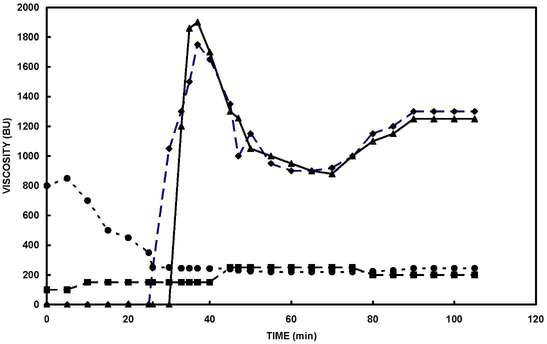
Figure 1. Amylographs of native and pre-gelatinized starches. Spray-dried extruded m, native drum-dried
Amylograph viscosity showed that spray-drying was the less drastic among the three processes, producing a starch which has similar amylograph viscosity than the native starch. On the other hand, amylograph viscosity obtained from extruded starch showed a low and constant viscosity along the heating-cooling profile (Fig 1). This could indicate that under extrusion cooking conditions, the temperature and the shear stress applied during process caused high molecular degradation. Drum-dried starch showed a high viscosity at cold temperature, which decreased with the increment of temperature. The setback in the cooling stage was negligible for both, drum-dried and extruded starches (Fig 1).
The high viscosity of the drum-dried starch at low temperature leaded to choose this thermal modification for further improvements. An increment of the setback, higher retrogradation, was achieved by trying out different drum-drying parameters with different rotating speeds and water-starch ratios (Fig 2). Drum-dried sample prepared with a water: starch ratio of 1:1, and 6 rpm was jelly-like, showing low initial viscosity and high setback. The sample at water-starch ratio of 1:1, and at 8 rpm showed high initial viscosity, but no setback behavior. A jelly like product with moderate initial viscosity but without setback was obtained by drum-drying with a water: starch ratio of 1.5:1 and 8 rpm. The sample at 1.25:1 water: starch ratio and 8 rpm, showed a high initial viscosity and slight setback. Drum dried starch at water: ratio of 1:1 and 8 rpm was chosen as the pre-gelatinization method for noodle preparation due to its high viscosity at low temperature, immediately after mixing with native starch and water, to be able to form the needed structure that replace gluten in noodle formation. Pre-gelatinized starch should also have good retrogradation properties (5).
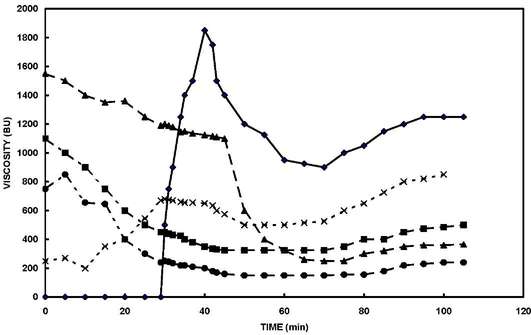
Figure 2. Amylographs of native and drum dried starches with different water: starch ratios. Native â¦, drum-dried 1:1 and 6 rpm x, drum-dried 1.25:1 and 8 rpm m, drum-dried 1:1 and 8 rpm â–² , drum-dried 1.5:1 and 8 rpm â¢
Noodles processing. Utilization of three mixtures, native C. edulis starch-wheat flour, pre-gelatinized C. edulis starch-wheat flour and native-pre-gelatinized C. edulis starch
Noodles were processed by partial replace of wheat flour with native or pre-gelatinized starch (Table 2). The amounts of wheat flour that were replaced were 4, 8 and 12%. The increase of native starch content in wheat flour noodle composition increased cooked weight, whereas an increment of pre-gelatinized C. edulis starch showed a reduction of the cooked weight with no significant difference. The solid loss results did not follow a special trend, however noodles made with mixtures of wheat flour and either native or pre-gelatinized starch had higher solid loss than wheat flour noodles. This shows that there is no improvement on the cooking stability (cooked weight and solid loss) of wheat flour noodles by adding either native or pre-gelatinized C. edulis starch.
Regarding noodles made with either native or pre-gelatinized starch, statistical analyses revealed the necessary processing parameters which permit to obtain noodles with the best cooking stability, highest cooked weight and lowest solid loss. Highest cooked weight was obtained by processing a mixture of 12 % pre-gelatinized starch, 28% native starch and 60% water; submerging in boiling water for 60 seconds; cooling in water at either 0°C or room temperature (no significant difference was found for the different cooling times); and drying in an oven at 45°C. The lowest solid loss was obtained for a mixture of 12 % pre-gelatinized starch, 28% native starch and 60% water; no significant difference was found for soaking times in boiling water, cooling times, cooling temperatures and drying temperatures. Therefore the optimal parameters to obtain noodles with the best cooking stability were: a mixture of 12 % pre-gelatinized starch, 28% native starch and 60% water; soaking in boiling water for 60 seconds; cooling in water at room temperature for 60 sec and drying at room temperature (Fig. 3).
The highest concentration of pre-gelatinized starch, 12%, may behaved as the best one during cooking due to a major leaching and further retrogradation of the amylose fraction, originated from the pre-gelatinized starch. The highest cooked weight of 12% pre-gelatinized starch noodles is explained by the fact that starch absorbs a higher quantity of water than native starch. Cooking the noodles straight after cold extrusion permits to increase the degree of gelatinization of the starch leading to a major leaching of amylose fraction from the starch granule. The retrograded amylose obtained during the cooling of noodles forms a network (3,6,7,27,28), which avoids the dispersion of starch components from the noodles to the water during the cooking. It seems than the retrogradation of amylose is mainly influenced by the rapid change of temperature, being performed in few seconds, which is explained by the fact that there was no difference for the different cooling times.
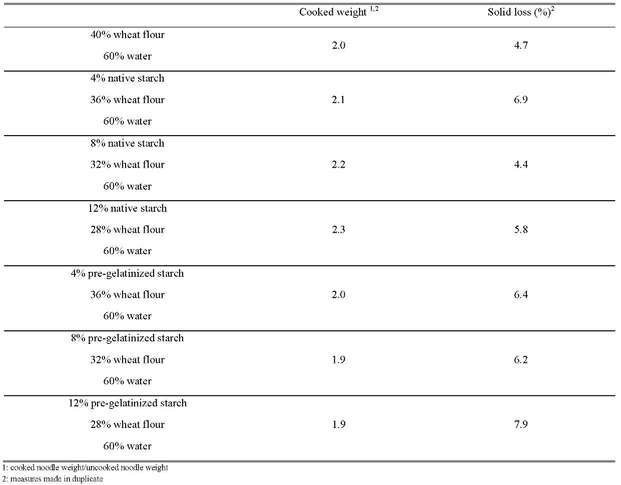
Noodle processing. Effect of heating-cooling treatments
The effect of heating-cooling treatments was evaluated with the comparison of two noodle samples, one corresponding to a sample obtained with the full noodle processing and the other sample obtained just after cold extrusion. The cooking treatment after the cold extrusion permits the dispersion of the amylose, which forms a network during the cooling treatment as a result of retrogradation. Such network may avoid the dispersion of the starch components during the cooking of noodles, therefore, reducing the solid loss from 14% to 2.5%, as is shown in Table 3.
Noodles made of a mixture of native starch and 12 % C. edulis pre-gelatinized starch were compared with commercial C. edulis starch noodles originating from Vietnam. Commercial samples showed higher cooked weight and solid loss than the produced noodles, Table 4.

Figure 3. Optimal parameters for noodles processing by using C. edulis starch
The highest concentration of pre-gelatinized starch. 12%. may behaved as the best one during cooking due to a major leaching and further retrogradation of the amylose fraction. originated from the pre-gelatinized starch. The highest cooked weight of 12% pre-gelatinized starch noodles is explained by the fact that starch absorbs a higher quantity of water than native starch. Cooking the noodles straight after cold extrusion permits to increase the degree of gelatinization of the starch leading to a major leaching of amylose fraction from the starch granule. The retrograded amylose obtained during the cooling of noodles forms a network (3.6.7.27.28). which avoids the dispersion of starch components from the noodles to the water during the cooking. It seems than the retrogradation of amylose is mainly influenced by the rapid change of temperature. being performed in few seconds. which is explained by the fact that there was no difference for the different cooling times.
Noodle processing. Effect of heating-cooling treatments
The effect of heating-cooling treatments was evaluated with the comparison of two noodle samples. one corresponding to a sample obtained with the full noodle processing and the other sample obtained just after cold extrusion. The cooking treatment after the cold extrusion permits the dispersion of the amylose. which forms a network during the cooling treatment as a result of retrogradation. Such network may avoid the dispersion of the starch components during the cooking of noodles. therefore. reducing the solid loss from 14% to 2.5%. as is shown in Table 3.
Table 3. Cooked weight and solid loss of noodles obtained after complete processing and only after cold extrusion. Mixture of native and 12 % C. edulis pre-gelatinized starch

Noodles made of a mixture of native starch and l2 % C. edulis pre-gelatinized starch were compared with commercial C. edulis starch noodles originating from Vietnam. Commercial samples showed higher cooked weight and solid loss than the produced noodles, Table 4.
Table 4. Comparison of cooked weight and solid loss of noodles made of a mixture of native and pre-gelatinized starch with commercial samples from Vietnam

Improvement of the quality of oriental noodles
The improvement of the quality of C. edulis oriental noodles was made by using a die with a lower diameter to produce thinner noodles. Thinner C. edulis noodles, 0.8 mm diameter, had a higher cooked weight and a lower solid loss than noodles of 1.5 mm diameter, Table 5. The low solid loss of thinner C. edulis noodles showed the improvement on the cooking behavior.
Table 5. Cooked weight and solid loss of noodles of two different diameters, both containing C. edulis pre-gelatinized and native starch together with protein fortified noodles
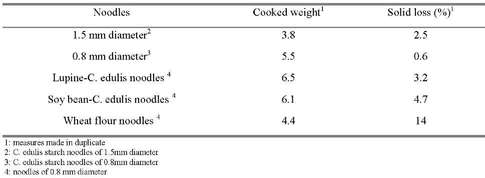
Protein enrichment
The protein content of lupine-C. edulis and soybean-C. edulis noodles were 16.5 and 11%, respectively. Mixtures of lupine-C. edulis and soybean-C. edulis noodles had higher cooked weight and solid loss than noodles prepared by using only C. edulis starch (Table 5). However the solid losses of the mixtures were lower than those of noodles prepared with wheat flour only.
Sensory evaluation
C. edulis noodles cooled at 0DC were lighter, rougher, more transparent and less agglomerated than C. edulis noodles cooled down at 17DC (room temperature). However there was no statistical difference.
C. edulis noodles cooled down at 0D C were softer, less chewy, less rubbery, less sticky and had a wet mouthfeel compared to C. edulis noodles cooled down at 17D C. However there was not statistical difference. The previous results leaded to conclude that the cooling step of the noodle processing can be done at room temperature since there is no improvement on the appearance and texture of noodles cooled down at lower temperature (0DC). Thick and thin C. edulis noodles (1.5 and 0.8 mm diameter, respectively) were darker, rougher and more transparent than the commercial samples (Fig. 4).
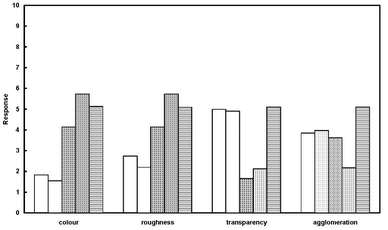
Figure 4. Sensory evaluation. Visual comparison of C. edulis noodles with commercial samples. Where the extremes on the y axis correspond to: color, 0 - dark to 10 - light; roughness, 0 - rough to 10 - smooth; transparency, 0 - opal to 10 - transparent; agglomeration, 0 - agglomerated to 10 - no agglomerated. Thin C. edulis, /.thick C. edulis, // thick rice, \\ thin rice, = mung bean.
Thin rice was the most agglomerated and mung bean showed to be the less agglomerated one, whereas thick and thin C. edulis were in between. Thick and thin C. edulis noodles were harder than the other samples (Fig 5). Thick and thin C. edulis noodles were similar in chewiness to the reference. Thick rice noodle showed to be the less chewy. Thick and thin C. edulis noodles were more rubbery than the other samples. There was no difference in adhesiveness among the samples. Thick rice, thick and thin C. edulis had a drier mouthfeel than the rest of the samples. A slight improvement in the appearance and texture of C. edulis noodles was found by reducing the diameter from 1.5 to 0.8 mm.
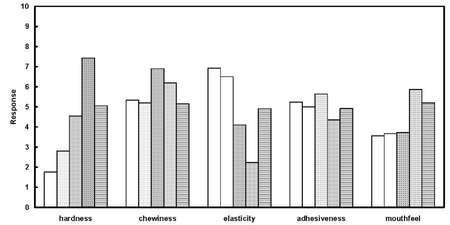
Figure 5. Sensory evaluation. Texture analysis of C. edulis noodles and commercial samples. Where the extremes on the y axis correspond to: hardness, 0 - hard to 10 - soft; chewiness, 0 - chewy to 10 - no chewy; elasticity, 0 - no rubbery to 10 - rubbery; adhesiveness, 0 - sticky to 10 - no sticky; mouthfeel, 0 - dry mouthfeel to 10 - wet mouthfeel. Thin C. edulis, /.thick C. edulis, // thick rice, \\ thin rice, = mung bean.
Protein enriched noodles showed that samples containing C. edulis smelled different than lupine and soybean, which were similar (Fig 6). Soybean noodles were darker than the others, which were similar. There was no difference in roughness among samples. Thin C. edulis and soybean noodles were more opal compared to lupine noodles. Thin C. edulis noodles were the less agglomerated and lupine noodles showed the maximum agglomeration. Lupine noodles had different flavor compared to the other samples, whereas soybean was similar to C. edulis (data not shown). Lupine and soybean noodles were softer, less rubbery and easier to chew than C. edulis. There was no difference in adhesiveness and mouthfeel among the samples.
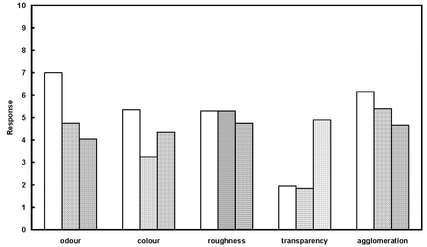
Figure 6. Sensory evaluation. Odor and visual comparison of C. edulis noodles with soy bean - C. edulis and lupine - C. edulis mixtures. Where the extremes on the y axis correspond to: odor, 0 - more odor to 10 - less odor; color, 0 - dark to 10 - light; roughness, 0 - rough to 10 - smooth; transparency, 0 - opal to 10 - transparent; agglomeration, 0 - agglomerated to 10 - no agglomerated. C. edulis, \\ soy bean - C. edulis and//lupine - C. edulis mixtures.
Consumers did not like the transparency of C. edulis noodles. The reason could be that the Ecuadorian people are used to eat wheat flour noodles, which are opal. Lupine-C. edulis noodles are opal as wheat flour noodles and were more accepted than C. edulis noodles. Soybean-C.edulis noodles were the less accepted by the consumers (Table 6). The intention of buying showed that from 39 possible consumers, 43.6% were willing to buy lupine-C. edulis, 43.6% C. edulis and 12.8% soybean-C.edulis.
Table 6. Appearance, texture, flavor and total score of acceptability results of noodles with protein enrichment

CONCLUSIONS
The present investigation shows the possibility of using local crops, i.e. C. edulis and lupine, for the processing of oriental style noodles in a small-medium scale. Drum drying showed to be best method to pre-gelatinize the starch for further noodle processing. C. edulis starch noodles with the best cooking stability were obtained by mixing 12 % pre-gelatinized starch, 28% native starch and 60% water, submerging in boiling water for 60 seconds, cooling in water at room temperature for 60 seconds and drying in oven at room temperature. Oriental style noodles with a good acceptability among Ecuadorian consumers can be produced by using a mixture of C. edulis starch and lupine flour. Moreover addition of lupine flour in the processing of noodles increased both. nutritional value and acceptability among consumers.
Notas
*Corresponding author: stalin.santacruz@gmail.com
REFERENCES
1. Hermann M. Arracacha and Achira Processing and Product Development. In CIP progress report 6310-1994. Quito. Ecuador: Mimeograph; . 1995. p. 8. [ Links ]
2. Hermann M. Starch noodles from Edible Canna (Canna edulis). In A Novel Use of an Ancient Root Crop. Indianapolis: Third New Crops . Symposium; October 22-25. 1995. [ Links ]
3. Mestres C. Colonna P. Alexandre MC. Matencio F. Comparison of Various Processes for Making Maize Pasta. Journal of Cereal Science. 1993; 17: p. 277-290. [ Links ]
4. Mercier C. Comparative Modifications of Starch and Starchy Products by Extrusion Cooking and Drum drying. In Pasta and Extrusion Cooked Foods. Mercier C. Cantarelli C. editors. London. UK: Elsevier Applied Science Publishers; 1986. [ Links ]
5. Pagani MA. Pasta Products from Non-conventional Raw Materials. In Pasta and Extrusion Cooked Foods. Mercier C. Cantarelli C. editors. London. UK: Elsevier Applied Science Publishers; 1986. [ Links ]
6. Mestres C. Colonna P. Buleon A. Gelation and Crystallisation of Maize Starch after Pasting. Drum-drying or Extrusion Cooking. Journal of Cereal Science. 1988; 7: p. 123-134. [ Links ]
7. Mestres C. Colonna P. Buleon A. Characteristics of Starch Networks within Rice Flour Noodles and Mung bean Starch Vermicelli. Journal of Food Science. 1988; 53(6): p. 1809-1812. [ Links ]
8. Chaiuss D. Some technological aspects of lupin versus soybean processing. In Lupin production and bio-processing for feed. food and other 8. by-products. Proceedings of the Joint CEC-NCRD Workshop held in Israel (Ginozar Kibbutz). Commission of the European Communities. DG XII. Publication EUR12641; 1990. [ Links ]
9. Dervas G. Doxastakis G. Hadiisavva-Zinoviadi S. Triantafillakos N. Lupin flour addition to wheat flour doughs and effect on rheological properties. Food Chemistry. 1999; 66: p. 67-73. [ Links ]
10. Hung T. Papalois M. Nithianandan V. Jiang H. Versteeg K. Utilization of lupin seeds for human consumption. In AIFST7NZIFST. "Food Pacific" Convention. Bond University; 1990; Gold Coast. [ Links ]
11. Liu K. Chemistry and nutritional value of soybean components Gaithersburg: Aspen Publ. Inc.; 1999. [ Links ]
Mateos-Aparicio I. Redondo Cuenca A. Villanueva-Suárez M. Zapata-Revilla M. Soybean. a promising health source. Nutr Hosp. 2008; . 23(4): p. 305-312.
13. Steele R. Harper A. Protein. In Present knowledge in Nutrition. Brown M. editor. 6th ed. Washington; 1990.
14. Miskelly D. Flour components affecting pasta and noodle color. J. Sci. Food Agric. 1984; 35: p. 463-471.
15. Oh N. Sieb P. Beyoe C. Ward A. Noodles: I. Measuring the textural characteristics of cooked noodles. Cereal Chem. 1983; 60: p. 433-438.
16. Oh N. Sieb P. Beyoe C. Ward A. Noodles: II. The surface firmness of cooked noodles from soft and hard wheat flours. Cereal Chem. 1985; . 62: p. 431-436.
17. Kruger J. Matsuo R. Preston K. A comparison of methods for the prediction of Cantonese noodle color. Can J. Plant Sci. 1992; 72: p. 102117. 1029. [ Links ]
18. Kruger J. Andersson M. Dexter J. Effect of flour refinement on raw Cantonese noodle color texture. Cereal Chem. 1994; 71: p. 177-182. [ Links ]
19 Santacruz S. Koch K. Svensson E. Ruales J. Eliasson A. Three underutilised sources of starch from the Andean region in Ecuador. Part I. Physico-chemical characterisation. Carbohydr. Polymers. 2002; 49: p. 63-70. [ Links ]
20. Guerrero M. Experimentación a escala "bench" de un proceso de desamargamiento de las semillas de chocho (Lupinus mutabilis). Obtención de esparteína y ensayos preliminares de texturización del concentrado protéico obtenido. Proyecto CONESUP-Escuela Politécnica Nacional. 1991;(88-04). [ Links ]
21. A.O.A.C. Association of Official Analytical Chemists. Official Methods of Analysis. 15th ed. Washington D.C.; 1990.
Ruales J. Nair B. Properties of Starch and dietary fiber in raw and processed quinoa (Chenopodium quinoa. Wild) seeds. Plant Foods for . Human Nutrition. 1994; 45: p. 223.
23. Anderson R. Conway H. Pfeiser V. Griffin E. Gelatinization of corn grits by roll and extrusion cooking. Cereal Science Today. 1969; 14: p. 4-
24. Ruales J. Development of an infant food from quinoa (Chenopodium quinoa. Wild). Technological aspects and nutritional consequences: . Ph.D. thesis. University of Lund. 1992.
25. Santacruz S. Estudio de las características del almidón de achira (Canna edulis) para su industrialización. Chemical Engineering thesis. Escuela Politécnica Nacional. Quito. Ecuador. 1995. [ Links ]
26. Wiesenborn D. Kim Y. Tostenson K. Analysis of Canna Starch and Canna Starch Noodle Samples. Cereal Science and Agricultural Engineering Departments. North Dakota State University. Unpublished work. 1995. [ Links ]
27. Miles M. Morris V. Orford P. Ring S. The roles of amylose and amylopectin in the gelation and retrogradation of starch. Carbohydr. Research. . 1985; 135: p. 271-281. [ Links ]
28. Sievert D. Würsch P. Amylose chain association based on differential scanning calorimetry. J. Food Sci. 1993; 58: p. 1332-1345. [ Links ]














